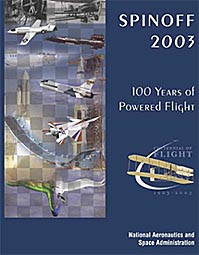
 |
|
NASA's
Spinoff
 Image Courtesy of NASA NASA's 'Spinoff' 11.11.04  Spinoff magazine cover
for 2003 In the 1958 Space Act that created the
National Aeronautics and Space Administration (NASA)
it was stipulated that NASA's vast body of
scientific and technical knowledge should also
"benefit mankind." These benefits are commonly
referred to as 'NASA spinoffs.' Every day, in an
astounding variety of ways, American lives are
affected positively by our Nation's investment in
NASA. Spinoff magazine cover
for 2003 In the 1958 Space Act that created the
National Aeronautics and Space Administration (NASA)
it was stipulated that NASA's vast body of
scientific and technical knowledge should also
"benefit mankind." These benefits are commonly
referred to as 'NASA spinoffs.' Every day, in an
astounding variety of ways, American lives are
affected positively by our Nation's investment in
NASA.Image to right: This year's issue showcases innovations such as the cochlear implant in health and medicine, a cockpit weather system in transportation, and a smoke mask benefiting public safety; many other products are featured in these disciplines. Credit: NASA Spinoff is NASA's annual premiere publication featuring successfully commercialized NASA technology. For more than 40 years, the NASA Commercial Technology Program has facilitated the transfer of NASA technology to the private sectors. The resulting commercialization has contributed to the development of commercial products and services in the fields of health and medicine, industry, consumer goods, computer technology and environment. Through distribution and outreach activities, NASA technology has benefited global competition and the economy. Since 1976, Spinoff has featured between 40 and 50 of these commercial products annually. Criteria for being featured in Spinoff:
The Spinoff Database What information is available in the NASA Spinoff database? The NASA Spinoff database contains abstracts of articles featured in NASA's annual publication Spinoff since 1976. The abstracts are a representative sampling of spinoff products and processes that resulted from technology utilization, or secondary application. The Spinoff database will help you find products/services that incorporate NASA technology in such areas as health and medicine, environment, public safety, consumer/home/recreation, transportation, computer technology and industrial productivity. You can find the date of the publication, page number, the center responsible for the technology, and the original NASA program in which the technology was developed if applicable. Spinoff Database |
|
All material on these pages, unless otherwise noted, is © Pegasus Research Consortium 2001-2019 |
 Webpages © 2001-2019 Pegasus Research Consortium |